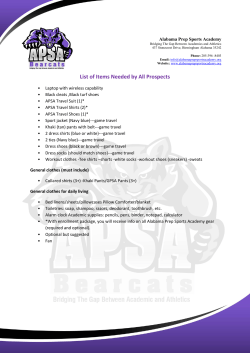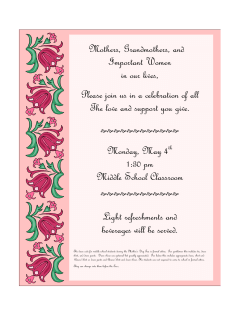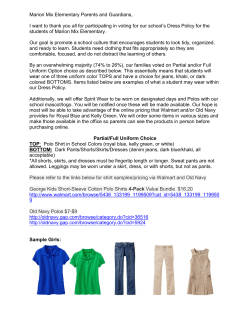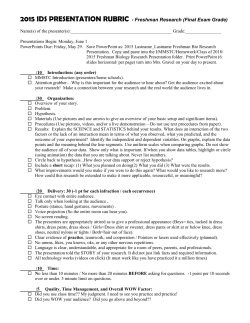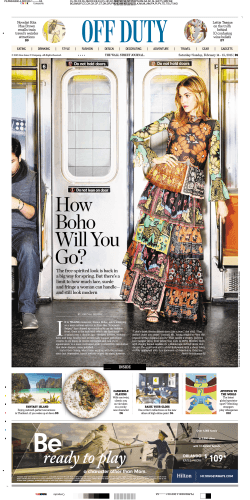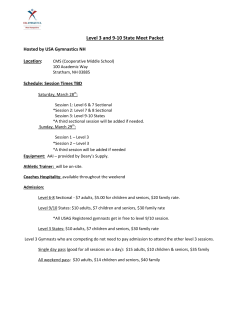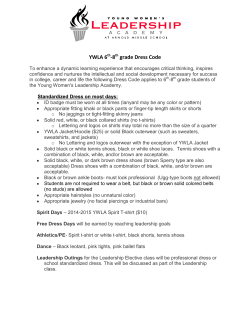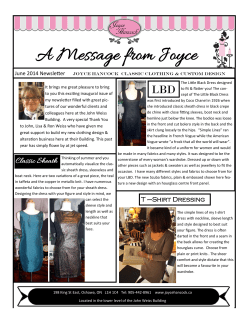
DRESS FOR SUCCESS / FIELD EXPERIENCES DRESS CODE
DRESS FOR SUCCESS / FIELD EXPERIENCES DRESS CODE Many times in life situations a person is judged upon how well dressed they appear. The same holds true for teachers, whether in the classroom setting, during a job interview, for a teacher parent conference or open house. Teachers should dress for success everyday of the week. Field experience students should always consult their mentor regarding the established dress code of their particular school. Failure to dress appropriately can impact the way an administrator, other teachers, students and parents perceive the teacher in question. Dressing for success allows teachers to gain the respect needed to set a positive example for their students. An important point to remember is that children are very good at modeling the behavior they observe in adults, particularly adults they respect. Dressing for success has three main effects for teachers: 1. Develop and maintain respect 2. Establish credibility 3. Establish yourself as an authority figure In developing your teaching wardrobe, keep in mind some of the following guidelines: 1. Stay stylish, but not over the top. You want to appear “with it” but you do not need to blindly follow every passing fad to a fault. A teeny-bopper persona is not a wise one to cultivate when dealing with parents who hope you are wise and responsible as you guide their young and impressionable children. Look for the classic in your closet or head to the mall for the old standards you still need. 2. If you’re young, be extra careful. No ageism here, just realism. It is likely that you are pre-judged as lacking teaching experience and hey, it is probably true, right? If you are just starting out or look particularly young, take steps to make your appearance more mature. This goes for men as well as women. In the age of botox, and obsession with youth, this might sound counter-intuitive, but teaching is one profession where a youthful look does not always inspire initial confidence. 3. Leave the bling at home. Do not chance an accident or the loss of meaningful jewelry. Simple, classic and minimal are the key words here. 4. Never show your undergarments. This includes bra straps and underwear when bending over. 5. Avoid cleavage. 6. Do not wear clothes with holes. The current fashion accepts distressed, damaged and worn jeans. You are not a student. Wear these items during non-working hours. 7. Wash and iron your clothes. In college, you may have rolled out of bed and grabbed the shirt off the floor. This is not acceptable in the workplace. 8. Pay attention to your shoes. You will be standing, so make sure they are comfortable. Avoid shoes that will attract students’ attention like super high, spiked heels. 9. Make sure your clothes fit properly. Too tight or too loose can be the target for student comments. A teacher should be comfortable in the clothes he or she is wearing. If you have any question regarding whether an outfit is acceptable or not, ask yourself if the outfit under question demands respect. The first impression is the only impression. Good luck! (Key points within this document were summarized from finding identified with the attached references.) References Lewis, B. (2009). The right threads=the right classroom atmosphere: How what you wear affects what you accomplish as a teacher. About.com - Elementary Education. Retrieved from http://k6educators/about.com/od/classroommanagement/a/attire.htm Stonskas, B. (n.d.). Dress codes for teachers. Helium.com. Retrieved from http://helium.com/items/1421481-basic-dress-for- teachers FIELD EXPERIENCE PROFESSIONAL DRESS REQUIREMENTS FOR TARLETON TEACHER EDUCATION STUDENTS Women & Men Hair: Natural colors, conservative hairstyles, neat and well groomed. Jewelry: Go conservative; no more than two earrings per lobe and must be on the lower portion of the earlobe; multiple bracelets and necklaces kept to a minimum so as not to be distracting. No visible tattoos or body piercing. Shoes: Shoes must be neat, clean, without scuffs or tears, and shined where appropriate; no heels higher than 3 inches; no athletic shoes, Crocs or flip-flops . PE: Professional shorts; Polo shirts, V-neck, finished round necked, mock turtleneck and turtleneck shirts; windsuits and matching sweatsuits; appropriate athletic shoes and socks; no inappropriate logos, messages or artwork. Hats or Head Covers: hats are not appropriate in the classroom; head covers that are required for medical and religious purposes or to honor cultural tradition are allowed. Name tag: Tarleton or ISD official name tag must be worn at all times in the public schools. EXCEPTION: Designated spirit days; nice blue jeans and a spirit building shirt can be worn. Women only Makeup: natural tones Tops: No strapless, spaghetti or halter tops, must not show any skin at the waist or midriff when arms are raised; neckline must be high enough that no cleavage is visible when bent over; no sheer material; not tight or form-fitting; appropriate foundation garments. Pants: Docker-style slacks or dress pants; pants must reach mid-calve; pants must be mid-rise or higher; belts must be worn if pants have belt loops; no jeans, shorts, skorts. Skirts/Dresses: Must not be too baggy or too tight; hemline must be no higher than the top of the knee; Men only Shirts: Polo or oxford-type shirts; no inappropriate logos, messages or artwork; must be tucked-in Pants: Docker-style slacks or dress pants; worn at the waist; plain belt; no jeans Recommendations for this document were provided by EDU 330 students during the summer of 2009.
© Copyright 2026
